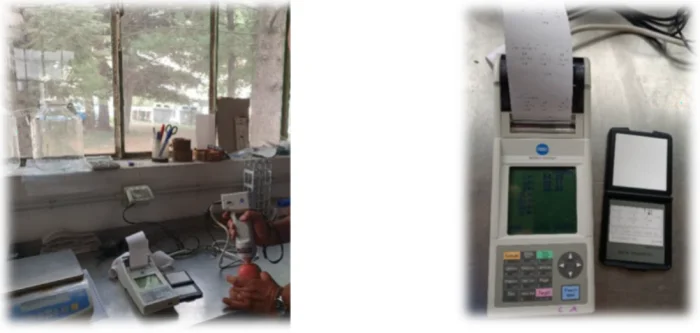During 2023, a fertilization test was set up in collaboration with the Technology Transfer Center of the Edmund Mach Foundation in San Michele all'Adige (TN), on the cultivar Fuji/ M9 in Spagolle in the municipality of Castelnuovo (TN) to test the performances of the FCP Cerea Glycos Plus product against an untreated thesis. Glycos Plus is a biostimulating product (N 5%, K2O 9%, with 10% organic carbon, B 0.25% and containing amino acids and algae extracts) recommended to improve fruit coloration, uniformity of ripening, sugar content and shelf life.
The test was carried out on a sandy, sub-alkaline soil, extremely calcareous but with low content of active limestone with high content of organic matter.
The plants, planted in 2019, are grafted on the M9 rootstock and bred with biaxial system (3.50 x 1.18), with planting density equal to 2414 plants per hectare (photo 1).

Photo 1: plants in bloom on 19 April, before setting the test and particular operation of measuring the area of the trunk section of both axes for the selection of plants to be used for measurements during the growing season, as well as the withdrawal of the entire unit production per plant.
Each thesis was replicated four times within the plot in elementary plots of 12 homogeneous plants. In each parcel, three representative plants were chosen, as they are homogeneous in the trunk section area, to carry out measurements of fruit growth.
The treatments with Glycos Plus were carried out at a dose of 2 L/ ha in three foliar applications to 45, 30 and 15 days after harvest. All distributions were carried out with the same pump and with volumes ranging from 1000 to 1500 L/ha in relation to the vegetative development of the plants.
From all the plots tested, two samples of 20 fruits each were taken five days before harvesting or on 5 October for qualitative analyses (starch, refractometric index, hardness, acidity, juiciness and Thiault’s index) and for color evaluations of the same using a spectrometer.

Photo 2: Measurements of the three L*a*b* color space coordinates using the CM-2600d spectrometer on different test samples.
Chemical thinning of the fruits was carried out on all the plants tested, while manual thinning was carried out after the June fall. It should also be borne in mind that in July there were hail events which partially affected commercial production but did not affect the test with regard to the results that had been set.
Fruit colouring and colour response
The evaluation of the three components of the color space through the use of the spectrometer on fruit samples taken shortly before harvesting shows that the thesis Glycos Plus favored a more intense coloring of the fruits towards the red direction compared to that CORPORATE-NT. Also the luminosity parameter, that is the one linked in inverse way to the coloration of the fruit confirms these results, since the thesis GLYCOS-plus has significantly lower values than the thesis COMPANY-NT (fig.1).

Figure 1. Average diameters of the plants sampled in the two theses at the three survey dates. Significantly different values are indicated by different letters. Significance levels are reported for values of P < 0.05. (Source: Fcp Cerea)
Regarding the objective of quantitative evaluation of the application of GLYCOS-plus, it is clear that the product tends to favor a more homogeneous distribution of fruits, as evident by analyzing the distribution of fruits in different size classes (figure 2) with values in the classes practically similar, while in the thesis NT-AZIENDA there are values in these classes more oscillating and crushed towards the central class and with fewer fruits, instead, in the higher class (> 90 mm).

Figure 2. Average weight per fruit of the plants sampled in the two harvest theses. (Source: Fcp Cerea)
The fruits sampled for qualitative analysis in the GLYCOS thesis compared to those of the NT-AZIENDALE thesis obtained a statistically higher size. The qualitative parameters showed no significant statistical differences. GLYCOS-plus was nevertheless found to be effective in slightly increasing sugar. Glycos Plus has therefore proved to be useful for improving the coloring and uniform maturation and size.
This is a further confirmation of what was also found on table grapes: the surveys carried out at harvest, in the province of Bari, in 2023, they showed a clear improvement in the coloring of the berries treated with Glycos Plus differentiating statistically from the witness and presenting a greater intensity of the coloring of pantons more tending to red even compared to the commercial standard (fig.3).

Figure 3: percentage of the 4 different shades of colour (pantone) in the three theses. The thesis with Glycos Plus is the one with the most accentuated coloring.
Figure 4. Comparison of some nutritional parameters in the three theses. Significantly different values are indicated with different letters. Significance levels are reported for values of P < 0.05. (Source: Fcp Cerea)

